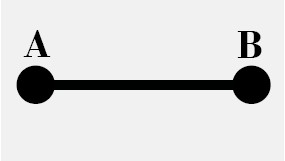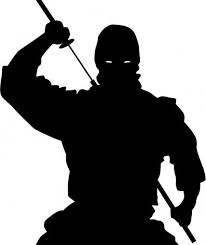By Braden Russell
We writers are like tightrope walkers. We can do beginnings and endings just fine, but when we get to the middle, things get a little wobbly.
Most of us, anyway. If you’re one of those rare individuals who can churn out brilliant middle sections with grace and ease, multiple appendages tied behind your back, a disdainful smile curling your mouth, then congratulations and more power to you. Now please exit the room--you're making the rest of us nauseous.
The rest of you, stick around. Thou art my brothers and sisters in affliction, those of us who slog through our middles with much groaning and gnashing of teeth, each keystroke a torturous plea to our snoring muse to please, please wake up and help us through this. Because we have absolutely, positively no idea where we're going with this thing. It stinketh.
And I’m not just talking about story middles, either. There is also the smaller middle, the part that comes between two set plot points. Here’s what I mean.

No, you’re not back in Algebra 1. These are two separate events in a story, Point A leading into Point B. In Point A your hero has been slammed with a completely unpredictable situation in which two bone-chilling consequences lie on either side of an unavoidable decision. Point B is the pride and joy of your right brain, a plot twist of ginormous proportions.
But something happened between those two points that brought the unbearable stench of lameness into your story, and no matter how hard you fan, it lingers in the air like the reminder of the trash can you should have emptied two weeks ago. And it’s depressing. Frankly, it’s making you wonder why you ever bothered with this novelling thing in the first place.
The problem has nothing to do with your plot points. They’re good. They’re original. The problem is that tiny innocent-looking horizontal line connecting the two. Therein lies the stinkage.
Let me backtrack a little bit. You know that in Point A your hero, a bold young ninja, has been slapped with the icky news that a massive army of mutant killer koala bears is five minutes away from demolishing his unsuspecting home village. He is given the news by his aged Sensei uncle, who has developed a severe ingrown toe hair that renders him helpless to do anything but hoarsely bid his young protégé to go and warn their beloved village. Our eager hero is just about to run and do just that, when he remembers something that turns his tender young blood to blueberry slushee. His fiance had informed him that morning that she was going to spend the day frolicking among the northern rice fields--incidentally, the direction that the mutant koala bears will be rampaging from. He hesitates for several excruciating moments, then runs off toward the rice fields, confident that he can warn the love of his life and still get to the village in time.
Fast forward to Plot B. Having failed to save his true love or the village, our hero wakes from unconsciousness on the cold stone floor of a subterranean dungeon. In sweeps the Evil Ninja Overlord of Shocking and Unmitigated Evilness, who removes his hood and reveals himself to be... (your reader waits with bated breath) ...our hero's Sensei uncle, who apparently has quite a gift for faking ingrown toe hairs.
(Okay, so perhaps the proportions of ol' Point B aren't particularly ginormous after all, but we can work with it.)
Now that we have our two plot points, all we need to do is connect them. We stare at our computer screen, scratch our noggin, and finally, itching to move on, slap down a quickie scene that we don’t have to think too hard about.
Our hero is running across the northern rice fields, his frolicking fiancee in sight, when he trips and falls, knocking himself out. Minutes later, the Koalas sweep by, kill his true love, raze the village, and take his unconscious body back to their leader. Right?
(Hint: Nope.)
That little horizontal line connecting Point A and Point B is just that--a short, straight line. It doesn't swerve, it doesn't deviate from its businesslike path. And this is what causes one of the most common writerly problems known to mankind. We use up all our brain-juice thinking up genius plot twists, and then don't have the creative energy to connect them with anything but that boring, predictable horizontal line.
How do we fix this? With a simple tool called reverse outlining.
Reverse outlining has become one of the favorite weapons in my creative arsenal. Don't let the name put you off if you are of that spontaneous camp known affectionately as "pantsers"--this technique works for outliners and pantsers alike.
To demonstrate, let's go back to our ninja story. Our first impulse might be to start at Point A, where he's deciding to go warn his fiancee, and try to shove ahead from there, figuring out the story in sequential order. This very well could work, but there's also a good chance that we'll just end up writing something as lame and groan-inducing as him tripping and knocking himself out on a rice plant.
Enter reverse outlining. Instead of trying to cram in some kind of filler scene to get us to the exciting stuff in Point B, we go to Point B and tell the story backwards.
So let's go to Point B, where the hero is lying chained in his uncle's dungeon, and look back. How did we get here? Well, the Koalas carried us in. What happened before that? He must have been captured, probably with some kind of big dramatic fight scene. But how did that happen? Wasn't he confident that he could move fast enough to get to his fiancee and the town in time? Maybe he just overestimated his speedy legs, but that's too boring to be the main impediment of the scene. Something must have happened to delay him in the rice fields. Maybe his dimwitted fiancee was too wrapped up in her frolicking to listen to a word he was saying. Or maybe she had a good reason to stay in the rice fields, one that he disagreed with. Maybe she was secretly on his uncle's side, and, while tossing an appropriately devious and scornful laugh in his face, told him so. This would be more than enough of a shock to delay our poor hero long enough to be swept up by the hordes of ravening Koalas.
Or… what if the fiancee was really an illusion the diabolical uncle had planted in the hero's mind many years ago with his twisted psychological powers, and never really existed at all?
This completely changes the genre of our novel, but you get the idea. Corny though it be, it sure beats that wimpy little horizontal line we started with.
This is a very simple technique, and it may not seem earthshaking or revolutionary enough to make that much of a difference, but there's a very good reason why it works so darn well.
It all comes back to the rule of Hindsight 20/20. Looking ahead and trying to estimate what the future may hold will always be foggy and uncertain, at best. But looking back at the past, at events that have already taken place, the memories come into place with a satisfying click, and things that might have confused the bejeezers out of you at one time all make sense now. It works the same way in your stories, as weird as that sounds. It's almost a psychological gimmick.
This technique becomes invaluable when you hit your Big Middle--for most novels, that's the seventy-five percent or so of story that lies between Act One and Act Three. This is where the fun stuff happens. This is where we get to write the epic battles, the breathtaking chase scenes, and all those fight sequences we’ve choreographed in the shower. Unfortunately, this is also the part that makes most of us want to strangle our fledgling story with its own entrails. Because Act Two is where the problem of Boring Horizontal Line becomes epidemic. We have our plot twists, our little black dotty points on our storyline, but now they're spread out over seventy-five percent of the novel. And we're racking our brains trying to figure out how to get from insanely clever plot twist No. 1 to epic battle to ravaging defeat to astonishing discovery and insanely clever plot twist No. 2.
TOO MUCH, our tortured brain sobs, and we either write an anti-climactic midget of an Act Two, or we give up and pack our poor unfinished works of fiction off to the Home for Abandoned Stories like the worst parents in the world.
That's what happened to me in my first novel, The Nephilim Project. At the end of Act One, my hero, Greg, was running for his life, dogged by creepy shaven-head dudes who wanted him for a nefarious and top-secret genetic experiment. Because of a last-ditch plan that cost him the life of his mentor, Greg was able to make contact with an underground resistance group who smuggled him back to their headquarters, where he was safe... but not really, because unbeknownst to any of the good guys, the creepy shaven-head dudes had managed to get a spy inside the rebel headquarters.
And then I hit the Big Middle. I knew that Act Three would open with Greg finally captured by the bad guys, lying on his back in a bare concrete cell with a cracked rib and a majorly pouty attitude. I also knew how that would escalate into my climax, then glide down into a satisfying last scene. I just had no clue what would happen before that. I didn't know how to fill Act Three.
So I had Greg chilling with the rebels for a couple of chapters, recovering from a couple of injuries and really just killing time. Then he decided to volunteer for an undercover operation (of a degree of lameness that prevents me from disclosing the full details here) and the rebels are all gung-ho about letting the untrained newbie go take care of this super important thing, and they send him on his merry way in a car. Which is driven, incidentally, by the evil spy. One chase scene later, Greg is captured.
Can anyone say convenient? Not to mention short. My Big Middle had become a Dinkie and Most Unimpressive Middle.
When I went back to rewrite the novel, it became clear that Act Two was going to need some serious beefing up. After a L.M. Montgomery-esque period of languishing in the Depths of Despair, I decided to try reverse outlining.
First I went to the beginning of Act Three. Greg captured, broken rib, concrete cell. How did he get there? Well, duh. He was dumped there by the bad guys. How did they manage to capture him? They chased him down and cornered him somewhere, right? Which meant he had to be out in the open, not hiding in the rebel headquarters where he was safe. Why the heck was he running around outside, where he knew he ran the risk of being nabbed? Forget the lame secret mission thing for now--let's give him another reason for putting himself in danger. Is he looking for something, or somebody? Maybe he's on a mission so deeply personal that he snuck back out of the rebel headquarters to accomplish it.
Or maybe he was running from something other than the creepy shaven-head dudes. Maybe it was something he had stumbled onto inside the rebel headquarters, something so [fill in the blank] that he would sooner risk capture by his enemies than stick around there. Now that opens a whole new world of possibilities... and there's a chance that once I figure out what this nameless thing is, I could have a whole lot more material to construct my Act Two with.
So that’s reverse outlining for ya. Try it, just once. Who knows, it may give you that elusive twist you've been scouring your brain for.
Oh, and if you ever figure out what happens to our ninja friend, let me know. I'm stuck there.





Awesome article as always Braden! Keep it up 🙂
Just wanted to say this is probably the third or fourth time I’ve come back to read this article. That’s how helpful it is. Thanks so much for writing it, Brandon!
*Braden, not Brandon. Sorry about that!
Ok…this is seriously the most hilarious and helpful article on plotting (possibly even writing) I have ever read! Braden, you have a great way with words! I was engaged and smiling the whole time – and learning a valuable plotting method. Thank you so much!
Ok… I know this is an older article… but can I just say this:
.
.
.
.
.
.
.
.
.
.
.
.
.
.
.
.
.
.
.
.
.
.
.
.
.
.
.
.
.
.
.
.
.
.
.
.
.
.
“FINALLY SOMEONE ELSE WHO USES THE TERM BRAIN JUICE!! I THOUGHT I WAS ALONE IN THIS!!!”
(Also, really swag article – the humor is perfect, the Koalas are totally unrealistic, and the tips underneath the funniness are so helpful. Plus, you speak like I do. XD)